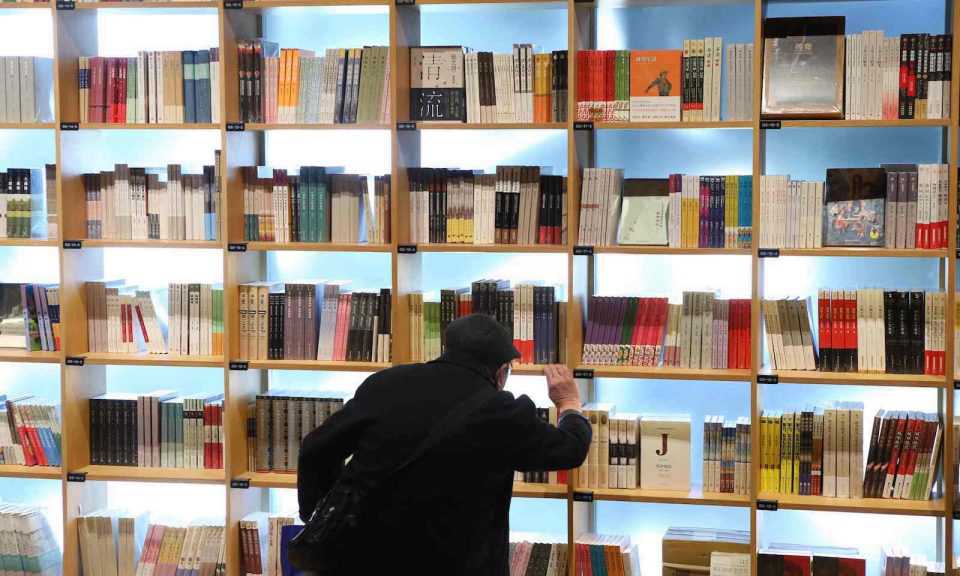China opens a new chapter in the bookstore revolution
02 February, 2018

Inside the 'Space of Light' bookstore in Shanghai. Photo: AFP
‘Space of Light’ complex in Shanghai links the stunning Xinhua Bookshop with the Pearl Art Museum, heralding a renaissance in the industry
Tadao Ando believes in the concept of “beauty.” His use of light and shade is stamped on every building he has designed and is a reflection of his philosophy in life.
At 76, he is probably Japan’s greatest living architect with a body of work which includes the Modern Art Museum in the United States city of Fort Worth, the Chichu Art Museum on the island of Naoshima in Japan and the Church of the Light chapel in Osaka.
“I would like my architecture to inspire people to use their own resources, to move into the future,” he has been quoted as saying. “You can’t really say what is beautiful about a place, but the image of the place will remain vividly with you.”
It is this approach that has made his buildings so haunting and yet so accessible. Hardly surprising then, that his latest creation merges the arts.
The two-story “Space of Light” complex covers about 4,000 square meters of the Aegean Place shopping mall in the mainly residential Minhang district of Shanghai in China.
On the seventh floor, there is the Xinhua Bookstore, while just above is the Pearl Art Museum. They link and intertwine through Ando’s trademark oval-shaped architecture.
“It’s just like covering a normal building with an ‘egg,’ creating new effects of light and shade inside,” he told the state-run cable television channel CGTN. “An egg symbolizes hope and life, and the design embraces the light of life.”
In a new chapter for the Xinhua Bookstore brand, the doors opened on “Space of Light” last month to coincide with the state-owned publisher’s 80th anniversary.
At its peak, the company had around 17,000 stores but now the figure is probably at least half that although figures are sketchy. Still, traditional brick-and-mortar outlets are back in vogue after being badly hit by the online sector.
Last year, book retail sales came in at 80.3 billion yuan (US$12.3 billion), a jump of more than 14% compared to 2016, a report released by the Publishers Association of China revealed.
“The country’s rising middle class with higher disposable income is boosting the demand for books,” Publishers Weekly, the American trade news magazine, stated.
The rapid rise in independent outlets in major cities such as Beijing, Nanjing, Shenyang and Hefei are part of this literary renaissance along with the government’s decision to introduce subsidies and tax breaks.
Data from People’s Daily showed that 5 billion yuan annually has been pumped into the sector since 2013, while the Ministry of Finance has also provided 670 million yuan in funding to bookstores during the past five years.
“It is still difficult for physical bookshops to survive. So, more government support is vital,” Zhai Defang, who is chief co-editor at SDX Joint Publishing and the general manager of the independent Sanlian Taofen Bookstore in Beijing, told China Daily.
Yet that is only one answer to a multi-layered problem. During the past few years, traditional bookstores have morphed from dingy, uninspiring places into walk-in art venues with coffee bars and public “readings”.
Sinan Shuju is a typical example. The 30-square-meter “experimental space” in Shanghai opened on a temporary basis at the end of last year to public acclaim.
Writers were brought in to talk about their favorite authors with customers before giving public readings. The outlet proved so popular, there are plans for it to open on a permanent basis.
Another success story has been Da Yin, or the Big Hideout Bookstore, which is also based in Shanghai. Last year, the chain held more than 300 events at its five stores, including book launches, workshops, live performances and even flea markets.
“The industry is breaking down old business models and liberating itself,” Cheng Sanguo, the head of Bookdao New Publishing Institute, told Shanghai Daily. “This time, it is not only a revival but also a rebirth – brand new from inside out. There are more opportunities and potential to be discovered.”
Ando’s homage to the written word captures that perfectly, with its winding bookshelves and deft use of light and shade. By melding the arts, he has managed to bring alive the “beauty” of literature inside a cathedral of design.
“I hope the space will increase people’s encounters with one another and with the books,” Ando, who won the 1995 Pritzker Prize, or the “Nobel of architecture”, told the Chinese media.
For him, space is the final frontier, a concept that China’s traditional bookstores have been slow to embrace.
TAG(s):
